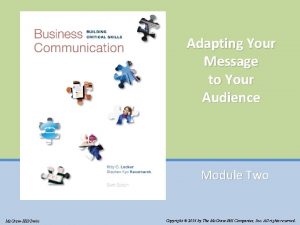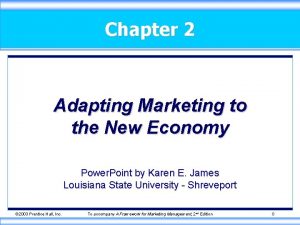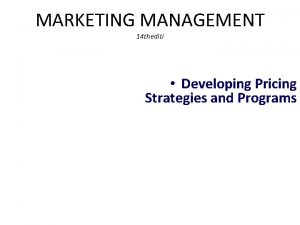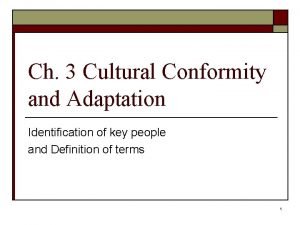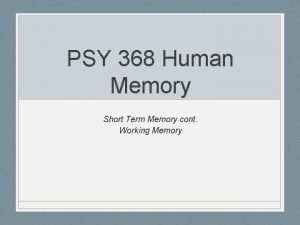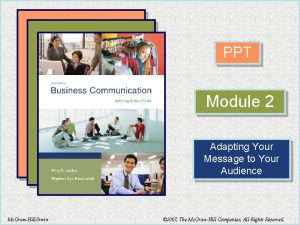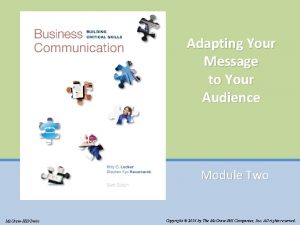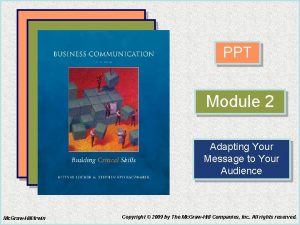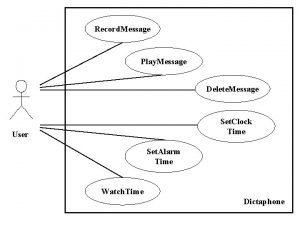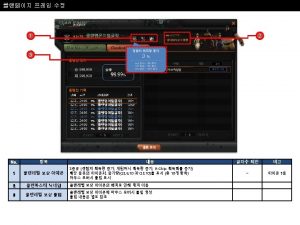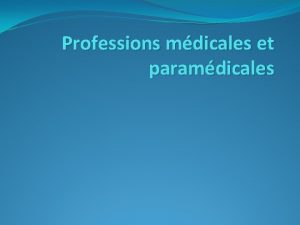Introduction to Health Professions Adapting Your Message to
















- Slides: 16

Introduction to Health Professions Adapting Your Message to Your Audience 1 -1

Understanding What Your Organization Wants � Succeeding in an organization depends first on understanding what “counts” at your organization. ‒ Ask your boss, “What parts of my job are most important? What’s the biggest thing I could do to improve my work? ” ‒ Listen to the stories colleagues tell about people who have succeeded and those who have failed. ‒ Observe.

Kinds of Audiences � Initial Audience � Gatekeeper � Primary Audience � Secondary Audience � Watchdog Audience

PAIBOC P What are your purposes in writing? A Who is (are) your audiences? I What information must your message include?

PAIBOC continued B What reasons or reader benefits can you use to support your position? O What objections can you expect your reader(s) to have? C How will the context affect reader response?

The Communication Process The Communication Model � � � Perception Interpretation Choice/ Selection Encoding/ Decoding Channel Noise

Audience Analysis Factors � Empathy � Knowledge � Demographic Factors � Values and Beliefs � Personality � Past Behavior

Discourse Community � A group of people who share assumptions about ‒ What channels, formats, and styles to use. ‒ What topics to discuss. ‒ How to discuss topics. ‒ What constitutes evidence.

Organizational (Corporate) Culture � Norms of behavior in an organization are revealed ‒ Verbally through the organization’s myths, stories, and heroes. ‒ Nonverbally through the allocation of space, money, and power.

Adapting Messages to an Audience � Strategy � Organization � Word Choice � Document Design � Photographs and Visuals

Gatekeepers and Primary Audience � To reach, focus on ‒ Content and choice of details. ‒ Organization. ‒ Level of formality. ‒ Use of technical terms and theory.

Written Messages � Make it easier to ‒ Present many specific details. ‒ Present extensive or complex financial data. ‒ Minimize undesirable emotions.

Oral Messages � Make it easier to ‒ Answer questions, resolve conflicts, and build consensus. ‒ Use emotion to persuade. ‒ Get immediate action or response. ‒ Focus the reader’s attention. ‒ Modify a proposal unacceptable in its original form.

Communication Channels � Channels vary according to ‒ Speed. ‒ Accuracy of transmission. ‒ Cost. ‒ Number of messages carried. ‒ Number of people reached. ‒ Efficiency. ‒ Ability to promote goodwill.

For Written and Oral Messages � Adapt the message to the audience. � Show the audience how it will benefit from the idea, policy, service, or product. � Overcome any objections the audience may have.

For Written and Oral Messages (cont. ) � Use you-attitude and positive emphasis. � Use visuals to clarify or emphasize material. � Specify what the audience should do.
 Paiboc model
Paiboc model Allied health professionals list
Allied health professionals list Adapting to your audience
Adapting to your audience In your notebook write question about the next school year
In your notebook write question about the next school year How well are we adapting
How well are we adapting Adapting marketing to the new economy
Adapting marketing to the new economy What is adopting materials
What is adopting materials Adapting to challenges of the micro environment
Adapting to challenges of the micro environment Adapting the price
Adapting the price The process of adapting borrowed cultural traits.
The process of adapting borrowed cultural traits. Adapting the price
Adapting the price How well are we adapting
How well are we adapting Adapting curriculum to bridge equity gaps
Adapting curriculum to bridge equity gaps Reading comprehension jobs and professions
Reading comprehension jobs and professions Most dangerous professions
Most dangerous professions Wickens
Wickens Between 1950 and 2000, physical activity professions
Between 1950 and 2000, physical activity professions
